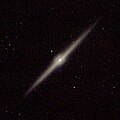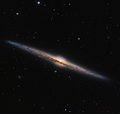| Revision as of 21:07, 20 December 2020 edit2603:6080:604:9299:bda1:4854:b616:30a3 (talk) NGC 4565← Previous edit | Revision as of 00:03, 21 December 2020 edit undo2603:6080:604:9299:bda1:4854:b616:30a3 (talk) NGC 4565Next edit → | ||
| Line 54: | Line 54: | ||
| NGC 4565 - Spitzer.png|] (]) | NGC 4565 - Spitzer.png|] (]) | ||
| Caldwell 38.jpg|NGC 4565 is also known as Caldwell 38. | Caldwell 38.jpg|NGC 4565 is also known as Caldwell 38. | ||
| NGC 4565 and 4562.jpg|] (left) and NGC 4565 (right) | |||
| </gallery> | </gallery> | ||
Revision as of 00:03, 21 December 2020
Spiral galaxy in the constellation Coma Berenices| NGC 4565 | |
|---|---|
 NGC 4565 NGC 4565 | |
| Observation data (J2000 epoch) | |
| Constellation | Coma Berenices |
| Right ascension | 12 36 20.8 |
| Declination | +25° 59′ 16″ |
| Redshift | 0.004103 |
| Heliocentric radial velocity | 1230 ± 5 km/s |
| Distance | 42.7 ± 12 Mly (13.1 ± 3.7 Mpc) 53 ± 4 Mly (16.2 ± 1.3 Mpc) |
| Apparent magnitude (V) | 10.42 |
| Characteristics | |
| Type | SA(s)b? |
| Apparent size (V) | 15′.90 × 1′.85 |
| Other designations | |
| UGC 7772, PGC 42038, Caldwell 38 | |
NGC 4565 (also known as the Needle Galaxy or Caldwell 38) is an edge-on spiral galaxy about 30 to 50 million light-years away in the constellation Coma Berenices. It lies close to the North Galactic Pole and has a visual magnitude of approximately 10. It is known as the Needle Galaxy for its narrow profile. First recorded in 1785 by William Herschel, it is a prominent example of an edge-on spiral galaxy.
Characteristics
NGC 4565 is a giant spiral galaxy more luminous than the Andromeda Galaxy. Much speculation exists in literature as to the nature of the central bulge. In the absence of clear-cut dynamical data on the motions of stars in the bulge, the photometric data alone cannot adjudge among various options put forth. However, its exponential shape suggested that it is a barred spiral galaxy. Studies with the help of the Spitzer Space Telescope not only confirmed the presence of a central bar but also showed a pseudobulge within it as well as an inner ring.
NGC 4565 has at least two satellite galaxies, one of which is interacting with it. It has a population of roughly 240 globular clusters, more than the Milky Way.
NGC 4565 is one of the brightest member galaxies of the Coma I Group.
Gallery
-
 Sloan Digital Sky Survey image of NGC 4565.
Sloan Digital Sky Survey image of NGC 4565.
-
 NGC 4565 by 2MASS
NGC 4565 by 2MASS
-
 HST image of NGC 4565
HST image of NGC 4565
-
 GALEX
GALEX
-
 NGC 4565 by the Mount Lemmon SkyCenter
NGC 4565 by the Mount Lemmon SkyCenter
-
 Spitzer (infrared)
Spitzer (infrared)
-
 NGC 4565 is also known as Caldwell 38.
NGC 4565 is also known as Caldwell 38.
-
 NGC 4562 (left) and NGC 4565 (right)
NGC 4562 (left) and NGC 4565 (right)
References
- ^ "Results for NGC 4565". NASA/IPAC Extragalactic Database. Retrieved 2006-10-12.
- ^ "Distance Results for NGC 4565". NASA/IPAC Extragalactic Database. Retrieved 2010-05-02.
- Jensen, Joseph B.; Tonry, John L.; Barris, Brian J.; Thompson, Rodger I.; et al. (February 2003). "Measuring Distances and Probing the Unresolved Stellar Populations of Galaxies Using Infrared Surface Brightness Fluctuations". Astrophysical Journal. 583 (2): 712–726. arXiv:astro-ph/0210129. Bibcode:2003ApJ...583..712J. doi:10.1086/345430. S2CID 551714.
- "NGC4565 at". apod.nasa.gov.
- Spiral Galaxy NGC 4565 at http://www.eso.org/public/images/eso0525a/
- ^ Globular Cluster Systems in Galaxies Beyond the Local Group
- "Intermediate-band surface photometry of the edge-on galaxy NGC 4565". iop.org.
- Detection of a Distinct Pseudobulge Hidden Inside the ``Box-Shaped Bulge of NGC 4565
- HALOGAS: H I Observations and Modeling of the Nearby Edge-on Spiral Galaxy NGC 4565
- ^ "Webb Deep-Sky Society: Galaxy of the Month: NGC4565". www.webbdeepsky.com. Retrieved 2018-05-20.
- Gregory, Stephen A.; Thompson, Laird A. (April 1977). "The Coma i Galaxy Cloud". The Astrophysical Journal. 213: 345–350. Bibcode:1977ApJ...213..345G. doi:10.1086/155160. ISSN 0004-637X.
External links
 Media related to NGC 4565 at Wikimedia Commons
Media related to NGC 4565 at Wikimedia Commons- NGC 4565 on WikiSky: DSS2, SDSS, GALEX, IRAS, Hydrogen α, X-Ray, Astrophoto, Sky Map, Articles and images
- National Optical Astronomical Observatory – NGC 4565
- APOD (2010-03-04) – NGC 4565: Galaxy on Edge
- APOD (2009-04-28) – NGC 4565
| Astronomical catalogs | |
|---|---|
| NGC | |
| PGC | |
| UGC | |
| Caldwell | |
| Caldwell catalogue | |
|---|---|
| List |
|
| See also | |